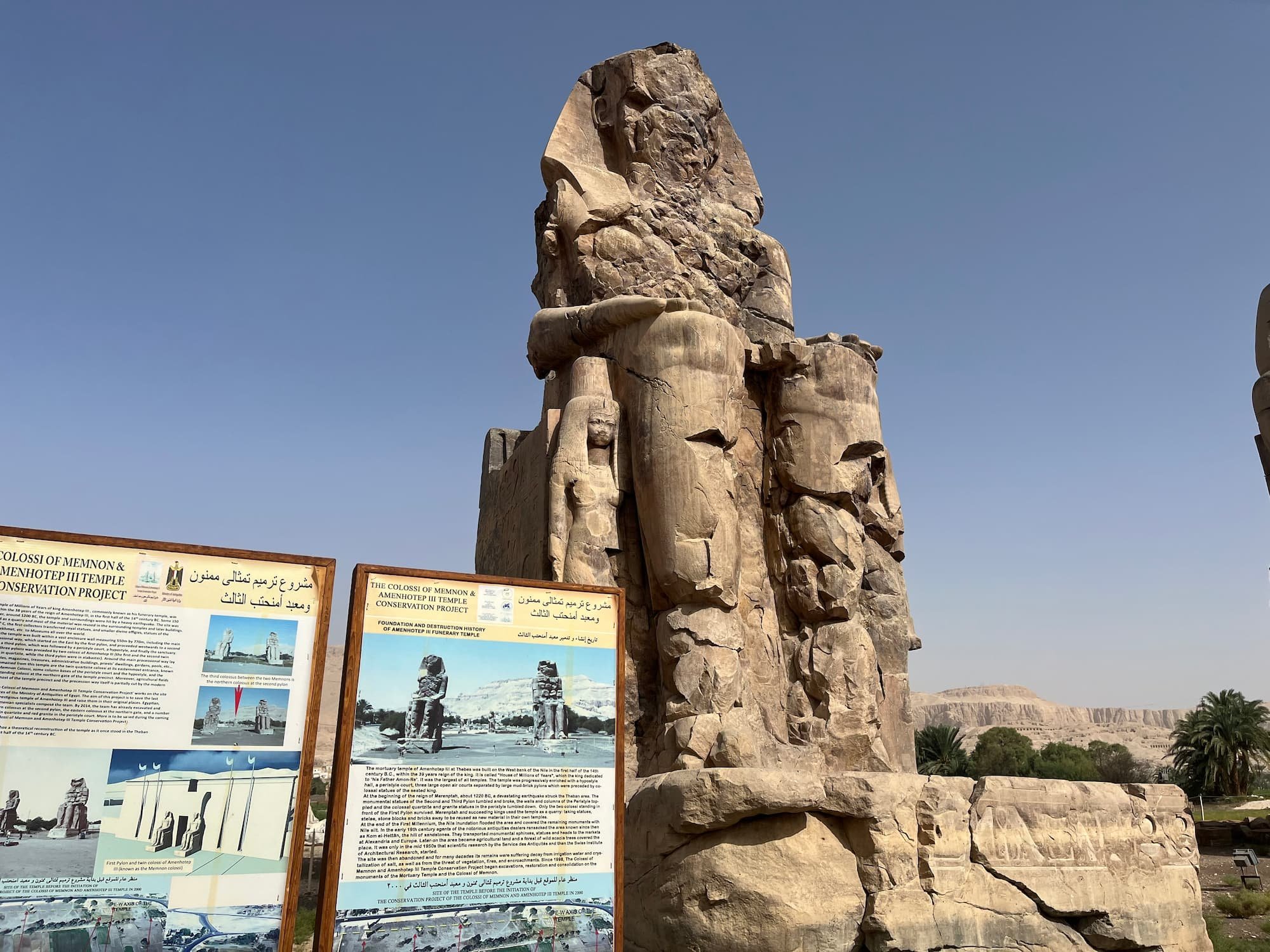A step back in time at the Colossi of Memnon in Luxor.
Imagine two Giant statues of a famous Pharaoh built to protect his mortuary temple, standing strong after thousands of years.
But their faces are missing!
The excitement for the full west bank tour was building on our way over the Nile, but first we had an unexpected pitstop.
The stop off at the Colossi of Memnon pleasantly surprised me - short, but sweet!
If you are heading to Luxor, but want to explore beyond the globally famous sites, then this blog is for you.
A quick stop at the Colossi of Memnon should be on any Luxor West Bank itinerary, so keep reading and find out all the information you need to go and visit the stone sculptures of Pharaoh Amenhotep III.
Our first view of the impressive colossi statues.
What are the Colossi of Memnon?
The treasure trove of ancient relics lures millions of tourists to Luxor each year!
It is no secret that most head to Luxor for the beautiful temples, or famous tombs, however, if you delve a little deeper into the history of the city, you find many other hidden gems.
The Colossi of Memnon are hidden gems with a great history, quirky modern look and an abundance of unique ancient tales!
The seated statues of ‘Amenhotep III’, who was the 18th Dynasty Pharaoh, were first built back in 1350 BCE, meaning they are over 3000 years old. When erected, towering at 60 feet, they were said to be the guardians of the pharaoh’s mortuary temple.
They were built out of single blocks of sandstone, and have remarkably stood the test of time, although earthquakes, flooding and wear and tear have meant that both statues have now lost their faces.
Although the statues don’t take first prize for the best photo setting in Egypt, they certainly match some of the other archaeological sites in terms of historical prowess.
I found the giant statue in the main exhibition hall in the Egyptian Museum in Cairo to be similar, although smaller than these statues.
Standing next to the statues show their scale.
Some ancient myths.
A perk of visiting famous sites on official tours, is the knowledge you acquire from the locals.
In this case, the ancient tales of the Colossi which have led to it being named an acoustic wonder of the ancient world. Historical folklore indicates that the statues used to whistle at sunrise, and although the Egyptologists in the modern world would like to believe that it is a ‘sign from the afterlife’, the phenomenon has been explained by science.
The cracks which run through the colossus as a result of an earthquake are likely the cause, along with vibrations from the heat of the sun, which explains the ‘sunrise’ part.
As with all of Luxor, I like to just imagine the past and create my own stories.
It makes it more fun!
The information boards help to present the sites’ vast history in a simple way.
How can you visit the Colossi of Memnon?
Colossi of Memnon Opening times:
6am - 5pm daily.
Colossi of Memnon Entrance Fee.
Free for all visitors (most tours of the West Bank include this site).
The popular East Bank area of Luxor is just over 30 minutes drive from the statues. The site is located on the West Bank, therefore, you will have to cross the river Nile if you are based in the East Bank.
The Colossi of Memnon, Thebes, Al Qarnah, Al Qarna, Luxor Governorate 1341703, Egypt.
Visiting from other cities.
If you are coming south, straight from your Cairo city break, then the best option is booking the Luxor sleeper train, or if you are booking well in advance, you can get cheap internal flights between the capital and Luxor.
If heading North from the beautiful Aswan, then the train is the most viable option. The train journey between the two cities takes around 3 hours, but it can be late often, so make sure you factor this into your plans.
Booking an official tour is a great way to minimise stress of travelling between the sites, whilst ticking off multiple iconic landmarks!
The Colossi of Memnon conservation project.
Although the colossi are badly damaged, the locals are working hard to preserve them for future generations to enjoy.
The ‘Colossi of Memnon Conservation Project’ has been underway since 1998, which has seen some success in its efforts to present the life of Amenhotep III in the best way possible.
Through the cooperation of the Egyptian Ministry of Antiquities, some achievements so far have been:
Preserving the Colossi.
Structural reinforcement to stabilise both statues.
Regular cleaning.
Regular cleaning is carried out to keep the inscriptions clear.
Research for tourists.
There is research carried out to understand the history of the site, which is then presented to visitors.
Uncovering the original temple layout.
Excavations and analysis has allowed the locals to gain a deeper understanding of the temple's original layout and architectural features. This knowledge informs ongoing conservation efforts and future plans for potential reconstruction.
Local life near the Colossi site.
Colossi of Memnon facts.
There is no denying that the statues have a colourful past, so here are five facts for you:
Since 1979, The site of the Colossi of Memnon is now part of the UNESCO World Heritage Site of Thebes.
Each statue is around 52 feet (16 meters) tall and weighs around 750 tons.
Each colossus was created hundreds of miles away from Luxor, and transported on the river Nile via barges. A single block of sandstone was used per statue, demonstrating excellent skills from the workers.
There are scenes of Amenhotep III’s life depicted on the colossi through hieroglyphics.
Smaller statues have been found at the site of Amenhotep III’s wife and mother.
There is ancient art throughout Luxor.
My experience visiting the Colossi of Memnon.
I visited Luxor on a solo trip, so I booked on official tours to meet new people, and to gain valuable insights into the many wonders.
The West Bank tour was my second day of my time in the city, so I had my bearings of the place by this point. I booked the tour through my hostel for ease. I didn’t know that the Colossi were on the itinerary until we pulled up at the site.
Apparently it is very common for the tours to stop at this awesome site on the way.
Medinet Habu Temple is also another popular stop which is not always advertised.
My first impressions were ‘meh’, but then as we walked closer to see the scale of the statues, and read the information boards, the site became much more interesting!
The lack of faces on both colossi piqued my interest, as it was similar damage to that had occurred to statues in the Medinet Habu Temple. I thought it was awesome how well some of the inscriptions have been preserved, when you consider that they are around 3400 years old.
We only spent 15 minutes at the site, but this was more than enough to learn the history and admire the statues!
The statues showed similarity to the Colossi statues guarding the entrance at Luxor Temple.
Overall, it was a nice surprise on my tour. Sometimes the unexpected sites turn out to be the best, similar to Saqqara near Cairo.
A nearby ‘smoking shop’.
Other things to do in Luxor.
Luxor is abundant with activities to suit every type of traveller, so if you are planning your trip to the ancient city, then here are some ideas for you:
Museums.
There are several museums which showcase the vast history of the region, however, my favourite was the mummification museum on the main corniche.
It is home to some mummies like you have seen in horror movies!
Markets.
No trip to Egypt is complete without a trip to the bazaars!
Luxor Market is everything you would expect from an African souk; chaos, plenty of character, and just a little bit of stress - But it is a fun experience!
Camel rides or hot air balloon rides.
There are extraordinary ways of exploring the ancient treasures of Luxor, to really make your trip special.
A traditional camel ride through the desert is a popular alternative to the Pyramids experience, as are the sunrise hot air balloon rides.
Whichever option you choose, you are in for a one-of-a-kind experience.
Sample the local cuisine.
If, like I do, you enjoy sampling different cuisines in a new country, then Luxor is a good spot.
There are many highly rated authentic restaurants for you to choose from, however, plan ahead, as they can get fully booked on an evening.
The beautiful Karnak Temple.
Rather visit the Nubian city in Egypt?
If you want a different vibe, to the tune of Nubia, then Aswan should be your choice of city.
Despite being one of the oldest civilisations in Africa, the locals still maintain many of their original traditions, which makes for a very interesting visit. A trip to the Nubian museum, Gharb Seyhel Village, and Philae Temple will fill your itinerary up nicely.
You will have a much more chilled holiday, especially if you stay with one of the Nubian families on Elephantine Island.
A colourful home in the Nubian Village in Aswan.
Disclosure: I sometimes use affiliate marketing. This will not cost you anything, but helps with my travel costs. I only recommend companies I use myself.











